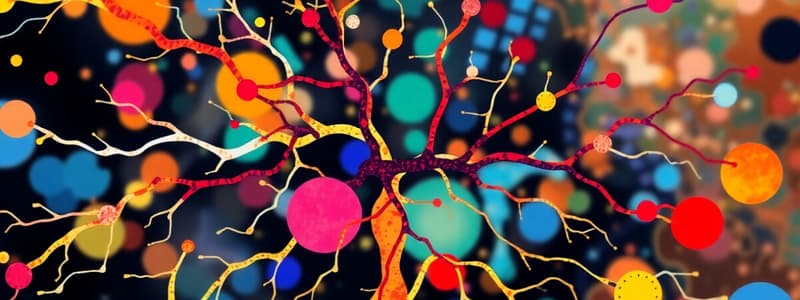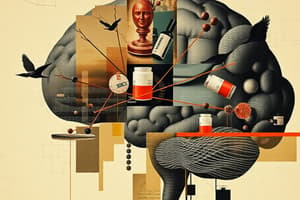Podcast
Questions and Answers
What is the functional unit of the nervous system?
What is the functional unit of the nervous system?
Which branch of the nervous system does the Autonomic Nervous System (ANS) belong to?
Which branch of the nervous system does the Autonomic Nervous System (ANS) belong to?
What type of receptors are involved in the autonomic nervous system?
What type of receptors are involved in the autonomic nervous system?
Which of these functions is NOT associated with the autonomic nervous system?
Which of these functions is NOT associated with the autonomic nervous system?
Signup and view all the answers
What role does the autonomic nervous system play in muscle contraction?
What role does the autonomic nervous system play in muscle contraction?
Signup and view all the answers
What type of impulses are typically transmitted through neurons?
What type of impulses are typically transmitted through neurons?
Signup and view all the answers
Which of the following best describes the Autonomic Nervous System?
Which of the following best describes the Autonomic Nervous System?
Signup and view all the answers
Which statement about neurotransmitters is correct?
Which statement about neurotransmitters is correct?
Signup and view all the answers
What is a primary function of the autonomic nervous system (ANS)?
What is a primary function of the autonomic nervous system (ANS)?
Signup and view all the answers
Which receptors are activated to cause pupil dilation?
Which receptors are activated to cause pupil dilation?
Signup and view all the answers
What is a key difference between the sympathetic and parasympathetic branches of the ANS?
What is a key difference between the sympathetic and parasympathetic branches of the ANS?
Signup and view all the answers
Which pharmacological action is associated with sympathomimetic drugs?
Which pharmacological action is associated with sympathomimetic drugs?
Signup and view all the answers
What action is associated with cholinergic receptors?
What action is associated with cholinergic receptors?
Signup and view all the answers
Which hormone is primarily responsible for increasing heart rate during stress?
Which hormone is primarily responsible for increasing heart rate during stress?
Signup and view all the answers
Which of the following actions does the parasympathetic nervous system promote?
Which of the following actions does the parasympathetic nervous system promote?
Signup and view all the answers
Which condition could be treated with sympatholytic drugs?
Which condition could be treated with sympatholytic drugs?
Signup and view all the answers
What is a common adverse reaction associated with adrenergic drugs?
What is a common adverse reaction associated with adrenergic drugs?
Signup and view all the answers
Which of the following neurotransmitters is primarily involved in the sympathetic nervous system response?
Which of the following neurotransmitters is primarily involved in the sympathetic nervous system response?
Signup and view all the answers
Which nursing consideration is important for patients receiving ANS drugs?
Which nursing consideration is important for patients receiving ANS drugs?
Signup and view all the answers
Which class of drugs acts by stimulating the parasympathetic nervous system?
Which class of drugs acts by stimulating the parasympathetic nervous system?
Signup and view all the answers
What effect does stimulation of beta1 adrenergic receptors have on the heart?
What effect does stimulation of beta1 adrenergic receptors have on the heart?
Signup and view all the answers
What physiological change is directly associated with adrenergic response?
What physiological change is directly associated with adrenergic response?
Signup and view all the answers
What effect does stimulation of cholinergic nerves have on the urinary bladder?
What effect does stimulation of cholinergic nerves have on the urinary bladder?
Signup and view all the answers
Which receptors are primarily involved in pupil constriction?
Which receptors are primarily involved in pupil constriction?
Signup and view all the answers
Which effect is associated with stimulation of the sympathetic nervous system (SNS)?
Which effect is associated with stimulation of the sympathetic nervous system (SNS)?
Signup and view all the answers
What is the effect of sympathomimetic drugs?
What is the effect of sympathomimetic drugs?
Signup and view all the answers
Which of the following is a side effect of increased norepinephrine levels due to adrenergic drug use?
Which of the following is a side effect of increased norepinephrine levels due to adrenergic drug use?
Signup and view all the answers
What role do nicotinic receptors play in the body?
What role do nicotinic receptors play in the body?
Signup and view all the answers
What is the primary action of muscarinic receptors on the gastrointestinal (GI) tract?
What is the primary action of muscarinic receptors on the gastrointestinal (GI) tract?
Signup and view all the answers
Which of the following conditions could be treated using sympathomimetic drugs?
Which of the following conditions could be treated using sympathomimetic drugs?
Signup and view all the answers
What is a potential consequence of mixing alpha and beta-adrenergic agonists with OTC preparations?
What is a potential consequence of mixing alpha and beta-adrenergic agonists with OTC preparations?
Signup and view all the answers
Which of the following anatomical locations contains nicotinic receptors?
Which of the following anatomical locations contains nicotinic receptors?
Signup and view all the answers
What type of neurotransmitter is involved with muscarinic effects?
What type of neurotransmitter is involved with muscarinic effects?
Signup and view all the answers
Which of these effects is closely associated with adrenergic receptor stimulation?
Which of these effects is closely associated with adrenergic receptor stimulation?
Signup and view all the answers
What is the primary physiological role of muscarinic receptors in sweat glands?
What is the primary physiological role of muscarinic receptors in sweat glands?
Signup and view all the answers
Which situation would most likely result from increased cholinergic activity?
Which situation would most likely result from increased cholinergic activity?
Signup and view all the answers
What is the effect of combining adrenergic agonists with adrenergic antagonists?
What is the effect of combining adrenergic agonists with adrenergic antagonists?
Signup and view all the answers
Which of the following substances increases the risk of overstimulation when taken with adrenergic agonists?
Which of the following substances increases the risk of overstimulation when taken with adrenergic agonists?
Signup and view all the answers
What is a primary characteristic of sympatholytic drugs?
What is a primary characteristic of sympatholytic drugs?
Signup and view all the answers
What is the action of drugs that bind primarily to alpha-receptors?
What is the action of drugs that bind primarily to alpha-receptors?
Signup and view all the answers
Which of the following medications is used to treat hypertension and heart failure?
Which of the following medications is used to treat hypertension and heart failure?
Signup and view all the answers
What is a common side effect of using adrenergic agonists?
What is a common side effect of using adrenergic agonists?
Signup and view all the answers
How do direct-acting cholinergic agonists work?
How do direct-acting cholinergic agonists work?
Signup and view all the answers
Which of the following conditions would contraindicate the use of cholinergic agonists?
Which of the following conditions would contraindicate the use of cholinergic agonists?
Signup and view all the answers
What is the primary role of parasympatholytic agents?
What is the primary role of parasympatholytic agents?
Signup and view all the answers
Which medication is used as a diagnostic agent for myasthenia gravis?
Which medication is used as a diagnostic agent for myasthenia gravis?
Signup and view all the answers
What is one effect of drugs that block the muscarinic acetylcholine receptors?
What is one effect of drugs that block the muscarinic acetylcholine receptors?
Signup and view all the answers
Which of these medications is indicated for open-angle glaucoma?
Which of these medications is indicated for open-angle glaucoma?
Signup and view all the answers
What mechanisms prevent norepinephrine from activating adrenergic receptors in sympatholytic drugs?
What mechanisms prevent norepinephrine from activating adrenergic receptors in sympatholytic drugs?
Signup and view all the answers
What is a notable side effect of atropine, a common parasympatholytic drug?
What is a notable side effect of atropine, a common parasympatholytic drug?
Signup and view all the answers
Study Notes
Pharmacology for Nursing - Unit II
- This unit covers the pharmacology of physiological systems, specifically Chapter 2: Drugs Acting on the Nervous System.
- The presenter is Dr. Hanan A.M. Youssef, RN, MNS, DNS, Associate Professor in Emergency & Critical Care Nursing at Taif University.
- The nervous system's major subdivisions are the central nervous system (CNS) and peripheral nervous system (PNS).
- The autonomic nervous system (ANS) is part of the PNS, further divided into the parasympathetic and sympathetic systems.
- The functional unit of the nervous system is a neuron, which has dendrites, a cell body, and an axon.
- Neurotransmitters like acetylcholine (ACh) and norepinephrine (NE) are crucial in nerve impulse transmission.
Major Subdivisions of the Nervous System
- Central nervous system (CNS): Includes the brain and spinal cord.
- Peripheral nervous system (PNS): Includes cranial and spinal nerves, connecting the CNS to other parts of the body.
- Autonomic nervous system (ANS): Control involuntary functions like heart rate and digestion, and is subdivided into parasympathetic and sympathetic systems.
- Parasympathetic system: "Rest and digest" system, responsible for slowing heart rate and increasing digestive activity - uses neurotransmitter ACh.
- Sympathetic system: "Fight or flight" system, responsible for increasing heart rate, blood pressure, and breathing - uses neurotransmitter NE.
Drugs Acting on the Nervous System
- Learning objectives include defining key terms, outlining ANS structures and functions, describing actions, indications, pharmacokinetics, contraindications, and interactions of drugs acting on the ANS.
- The chapter also covers comparison of prototype drugs with other agents in class.
- Topics include nursing considerations and patient teaching points for drugs acting on the ANS.
- Key terms include Acetylcholinesterase, Adrenergic receptors (alpha, beta), Belladonna , Cholinergic receptors, Glycogenolysis, Mydriasis , Monoamine Oxidase (MAO), Miosis, Muscarinic Receptors, Nicotinic Receptors, Parasympathomimetic, Parasympathetic System (PNS), Parasympathomimetic, Sympathomimetic Drug, Sympathetic Nervous System (SNS), Sympatholytic
- Understanding autonomic nervous system (ANS) and its components is fundamental.
Autonomic Nervous System (ANS)
- Definition: Involuntary or visceral nervous system
- Function: Mostly with little conscious awareness, regulates and integrates body's internal functions. Integrates parts of the CNS and PNS
- Location: Centers for the ANS mainly in the Hypothalamus, Medulla, and Spinal Cord
- Bodily functions regulated by the ANS: Blood Pressure, Heart Rate, Respiration, Body Temperature, Water Balance, Urinary Excretion, and Digestive Functions.
Agents for Treating Autonomic Nervous System Disorders
- Different classes of drugs are used to treat various disorders of the autonomic nervous system.
- Specific learning objectives for this section are provided.
- Discusses the use of adrenergic agonists and their indications across different age groups.
Studying That Suits You
Use AI to generate personalized quizzes and flashcards to suit your learning preferences.
Related Documents
Description
Test your knowledge on Chapter 2 of Pharmacology for Nursing, focusing on drugs acting on the nervous system. Learn about the major subdivisions of the nervous system, including CNS, PNS, and their associated functions. This quiz covers key concepts such as neurotransmitters and neuron structure.




